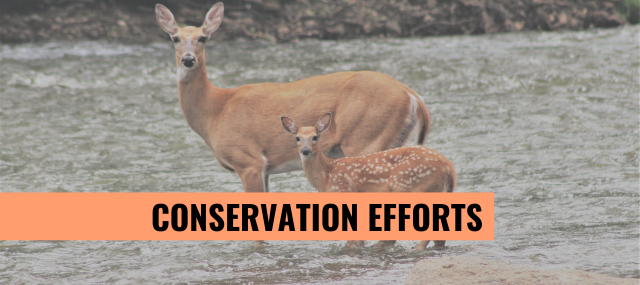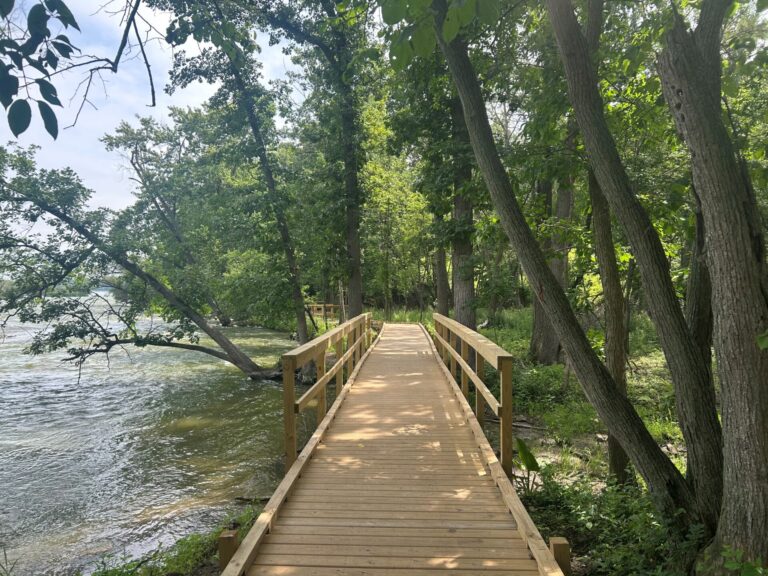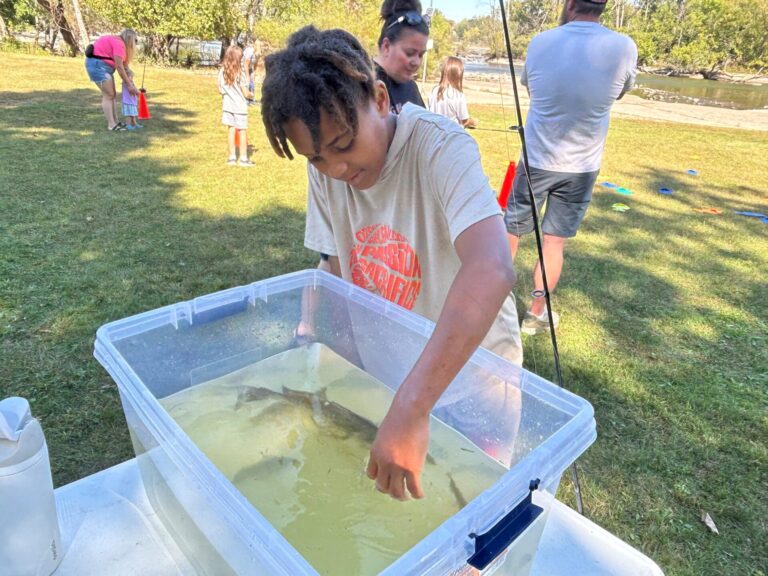On-Site Conservation
The Conservancy Zone is not immune to non-native plants and trees. Garlic mustard, dame’s rocket, and buckthorn are three highly invasive species that are invading our native habitat. 1000 Islands continues to work with sustainable organizations and utilize volunteers to help control these invasive plants.
In 2018, 1000 Islands started using goats to assist in controlling invasive species on the Conservancy Zone. Twice a year a local farmer brings his goats to 1000 Islands for them to graze and eat the invasive species. Results have been very positive in the areas where the goats have grazed. The goats are scheduled to return from September 22, 2025, at 12:30 PM through Sunday, October 5, 2025, at 5:30 PM. Weather permitting, they will be out daily from 8:00 AM to 5:30 PM, munching away on invasive plants.
Bald Eagles started coming to the 1000 Islands area in the late 1970s. The hydro dam, mills and great drop in the river elevation keeps the water open more than in other areas. The river also provides many fish, which is a primary source of food for eagles. The 350 acres of Conservancy Zone give the eagles a place on the river to navigate away from people.
Kaukauna and other cities and towns along the lower Fox River have become a popular spot for Bald Eagles to migrate to during the winter months. Some eagles have stayed in the area to build a nest and produce offspring.
Eagle watching along the lower Fox River can be spectacular. 1000 Islands has always been an ideal area each winter to watch eagles either perched in large trees along the water’s edge or soaring above. They are drawn to areas of open water in search of fish, their preferred food. Early morning or at sunset is a prime time during the day to see eagles flying and fishing.
Each year, on the 4th Saturday in January, 1000 Islands hosts Eagle Days. Eagle lovers of all ages come to watch eagles fishing, soaring overhead or roosting in nearby trees. Eagle Days is a family day and provides an educational program featuring a live bald eagle. Other activities include a full-size replica of an eagle’s nest, hands-on eagle activities, children’s crafts, coloring contest, door prizes and more. All activities are free.
1000 Islands works with City and State offices to control erosion and maintain our trail system. A prairie flower lawn mix was planted, along with planting hickory and sugar maple trees to help control erosion. Erosion is prevalent in numerous areas, but plans are in place for addressing erosion both at the Nelson Overlook and on the Hoersch property.
1000 Islands will continue to make choices that are environmentally responsible, economically viable, and socially equitable for the long-term stability of the Conservancy Zone and the City of Kaukauna.
Community Conservation
Since 2015 Bird City Wisconsin has selected the City of Kaukauna as an official Bird City, recognizing our efforts to celebrate and conserve our wonderful and diverse bird population. 1000 Islands Environmental Center played an instrumental role in achieving this recognition. Learn more by visiting our Bird City page.
Pollinators, including bees, butterflies, birds, bats, and other small mammals, are responsible for 1 of every 3 bites of food you eat. Without these pollinators, our food systems as well as our natural ecosystems are in trouble. Although more research needs to be done to fully understand the decline of pollinator populations including the causes and effects, it is important to take action now to better support our pollinators.
The City of Kaukauna, along with 1000 Islands Environmental Center, is promoting pollinator friendly actions that anyone can take part in to create pollinator friendly yards. See below for steps that you can take throughout the growing season to create better habitat for bees and other pollinators.
MARCH
Warm early spring days often get people excited to get out into their yards and start some spring cleanup. It is important to be patient to let the days reach consistent warmer temperatures and allow overwintering insects to emerge before tidying up your yard and gardens. Learn more with the Xerces Society.
APRIL
Early spring is a great time to plant native trees and shrubs as the plants are still dormant and the ground is usually pretty saturated from melting snow and spring rain. 1000 Islands holds an annual Seedling Sale with native plant species that support birds and pollinators. (More info can be found below.)
MAY
May is usually when things start greening up and growing in earnest. This is also one of the times of greatest growth in your lawns. Many communities encourage going the full month without mowing at all. In order to maintain the health of your lawn, including reducing the need for fertilizers or chemicals, consider reducing the frequency of your mowing instead of stopping altogether. This gives flowering plants such as dandelions and clover a chance to bloom, providing early season pollinator support while still allowing healthy root growth for your lawn and complying with your municipality’s noxious weed ordinance. For more information on healthy mowing practices, visit the University of Minnesota Extension Yard and Garden website.
JUNE
In addition to maintaining a higher grass height in your yard, remember to only cut a maximum of 1/3 of the grass height when mowing. As an example, to maintain 4″ of grass, only mow when the grass height reaches 6″. In addition to keeping your lawn healthier without the need for chemicals, this will result in a longer time in between mowing, reducing the disturbance to pollinators and other beneficial insects. In a study conducted by the U.S. Forest Service, it was concluded that “mowing less frequently is practical, economical, and a timesaving alternative to lawn replacement or even planting pollinator gardens. Given the pervasiveness of lawns coupled with habitat loss, our findings provide immediate solutions for individual households to contribute to urban conservation.”
JULY
Not all, but many of our pollinators are diurnal, or active during the day. Whenever possible, mow your lawns in the evening when much of the pollinator activity has slowed down for the day to reduce disturbance.
AUGUST
In the heat of the summer water is essential! We all know the importance of water for ourselves and our plants, but providing water sources for wildlife is important, too. Consider placing water sources in your yard for pollinators such as bees and butterflies. They are simple to create out of items that you already have around your house. Discover some water source ideas that will work for honey bees and native pollinators here.
SEPTEMBER
As the growing season starts to slow down, make sure to leave the stems of plants that are done growing, or going dormant, for the fall. Stems of various plants provide essential nesting and overwintering habitat for bees. Learn more about nesting and overwintering habitat with this Xerces Society Guide.
OCTOBER
Autumn brings falling leaves to our yards and lots of work raking them and removing them from the yard. Save yourself, and your municipality, lots of work by leaving the leaves. Leaf litter is an important part of your backyard habitat and a great way to support pollinators. Instead of removing them from your entire yard, leave the leaf litter in your gardens, landscaping or a back corner of your yard for overwintering insects such as bumble bees. Understand more of the benefits here.
NOVEMBER
As you say farewell to another growing season and prepare for winter, you can also take steps to making the next growing season even better for your backyard pollinators. Late Fall, especially right before your first major snowfall of the winter, is a great time to spread native plant seeds. Many of our native wildflowers need to go through a cold stratification period, or a stretch of time in cold conditions, before they will sprout. Spreading seeds now will set them up for growth in the spring. No space for a wildflower garden in your yard? No problem! Consider planting “bee lawn” seeds within your lawn to make next year’s Slow-Mow Summer even more successful. Learn more about Bee Lawns here!
CITIZEN SCIENCE
Participate in citizen science programs to help collect data on what you see in your own backyard and community. Check out the following program specific to Bumble Bees:
ADDITIONAL RESOURCES
University of Minnesota Bee Lab
Bald Eagle Nest Watch is a citizen science program in partnership with Southern Wisconsin Bird Alliance (Madison) and the Wisconsin Department of Natural Resources that seeks to better understand how bald eagles are doing in Wisconsin. Participants are matched with a bald eagle nest in our area and visit it once per week for an hour each time during nesting season (generally February through late May) to observe and document the presence of young and what the family is doing. All volunteers receive training that teaches them everything they need to know about bald eagles and the program.
The Naturalist at 1000 Islands is the coordinator for the Fox Valley Region (Outagamie, Winnebago, Calumet and Northern Fond du Lac counties) and is looking for volunteers to join the team of local nest watchers. We also appreciate getting information from the public about new or recently discovered nests in the area to add to our watch program.
For more information about Bald Eagle Nest Watch:
Bald Eagle Nest Watch — Southern Wisconsin Bird Alliance
To inquire about becoming a local BENW volunteer or to report an area nest to add to our watch program, please contact Naturalist Brad Garrity directly at 920.759.5676 or by email at [email protected]
1000 Islands Environmental Center holds a Tree and Shrub Seedling Sale to offer landowners and homeowners the opportunity to improve and protect the environment while beautifying and increasing the value of their property. All proceeds from the sale help fund environmental education programs and events at 1000 Islands. Thank you once again to Kaukauna Utilities for partnering with us and sponsoring the Seedling Sale.
2026 dates and information coming soon!




